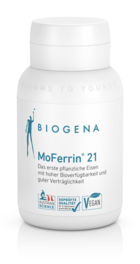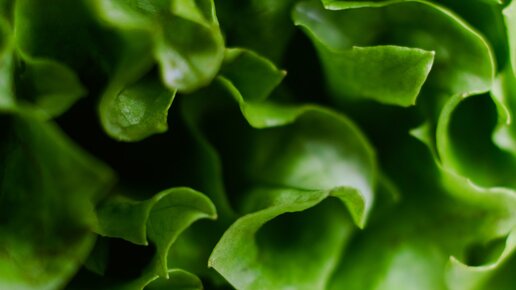Iron doesn’t just sound strong. It is strong. After all, the trace element keeps 179 iron-dependent bodily functions running. But unfortunately not everybody has the full complement. In fact, about one third of the world’s population has a deficiency. And Mr and Ms Austria are no exception, as the results of the BIOGENA Good Health Study* highlight. Learn more about the strong trace element, deficiency symptoms and various iron treatments.
What is iron? More about this trace element:
Iron is one of the nine essential trace elements. Approximately 3–4 g of iron can be found in the body.
What do we need iron for in the body? Functions & health benefits:
Iron …
- supports the normal formation of red blood cells and haemoglobin as well as the transportation of oxygen around the body.
- supports the health function of the immune system
- plays a role in cell division
- supports normal cognitive functions such as memory, attention (concentration), learning, intelligence and problem solving
- contributes to normal energy metabolism
- contributes to the reduction of tiredness and fatigue
Iron supports the transportation of oxygen in the blood
Humans cannot live without oxygen. They cannot live without iron either. As elementary as these elements are, their close connection to each other is equally fundamental. As an indispensable component of the blood pigment haemoglobin and the muscle pigment myoglobin, iron not only brings colour to life, it also binds vital oxygen to itself. Accordingly, the functions in the formation of red blood cells and haemoglobin as well as in oxygen transportation are among iron's leading roles. But this indispensable trace element can do more than that!
More energy through full iron storage
The oxygen that is transported by iron is required by the cells to generate energy. It is therefore not surprising that low iron levels primarily affect physical performance. Do you often feel tired and weak, complain about freezing and cold hands? Full iron stores, on the other hand, provide enough energy and a laboratory test of iron levels should be considered if you feel exhausted or tired.
Iron makes you smart
Since iron also supports cognitive functions, children and adolescents in particular need sufficient amounts of the trace element. However, a good supply of iron can also significantly support the ability to concentrate and learn in adults.
Daily requirement: How much iron is recommended per day?
Iron requirements are very specific to each person. They can vary between 1 and 4 mg daily. However, since only a small portion of dietary iron passes from the intestine into the blood, the recommended iron intakes are well above 4 mg. According to the D-A-CH reference values for nutrient intake, the following daily intakes are recommended depending on age, gender or stage of life:
| Group of people | Recommended iron intake (per day) | |
| male | female | |
10 to under 19 years | 12 mg | 15 mg |
19 to under 51 years | 10 mg | 15 mg |
From 51 years of age | 10 mg | 10 mg |
Pregnant women | - | 30 mg |
Brestfeeding women | - | 20 mg |
Table 1: Iron requirement per day according to age, gender & life situation
The daily iron recommendation from the German Nutrition Society (DGE) differentiates between children & adults, women and men. Pregnant women and breastfeeding mothers also have an increased requirement. More information can be found at https://www.dge.de/wissenschaft/referenzwerte/eisen
Which groups of people have an increased need?
Vegetarians & vegans, menstruating women, pregnant & breastfeeding women, athletes, children & adolescents and seniors are particularly affected by poorly filled iron stores and should pay attention to their iron levels.
Why do women have a higher requirement than men?
Blood loss during menstruation is about 100 ml. Thus, 10-30 mg of iron is lost per menstrual cycle. This must be compensated for, either through nutrition or through the targeted intake of a high-quality iron supplement.
Why do athletes have an increased requirement?
Athletes produce more red blood cells for additional energy production and therefore need more iron than inactive individuals. People who are particularly active are affected by iron deficiency. Even exercise at a recreational level leads to sweat losses of about one litre per hour. Since iron is also released in sweat, athletes lose considerable amounts of this important mineral. 0.2 to 0.5 mg of iron is lost per litre of sweat.
Why is iron important during pregnancy and breastfeeding?
Women have a "superpower": they can make people! But what sounds like a piece of cake actually demands a lot from expectant mums. After all, during pregnancy, it's not just about taking care of yourself. The growing baby also "eats" - a feat of strength that is also reflected in the mother's nutritional needs.
This form of additional demand is particularly clear in the case of iron, the need for which can as much as double during pregnancy. Most of the iron is needed for the blood supply of the expectant mother. By the end of the pregnancy, the mother’s blood volume increases by about 40 percent. This is to ensure a smooth supply of important nutrients for the unborn child.
Iron - How much does pregnancy cost?
During pregnancy ...
... the fetus needs about 300 mg of iron
... the placenta needs about 50 mg of iron
... approx. 450 mg of iron is drawn in for the mother’s increased blood volume.
A mother’s iron requirement is also increased during breastfeeding, with 20 mg of iron daily - instead of the usual 15 mg. This recommended additional requirement is intended to help the new mum to compensate for her losses due to pregnancy, birth and postpartum.
Measuring iron levels in the blood: How high should the blood values be?
Anyone who wants to know more about their own iron level should have their blood tested as part of a laboratory diagnostic examination. The iron value on the diagnostic sheet should not be overestimated. It is not particularly meaningful because it is not only subject to diurnal fluctuations, but also influenced by other factors (e.g. the iron content of food, certain medications, etc).
Ferritin: The iron store
Ferritin is also called storage or depot iron. In this form, the body "hoards" vital iron and can mobilise it when needed. If the ferritin value is low, this is an early sign of a poor iron supply - even before an undersupply becomes apparent.
Transferrin: The iron taxi
Transferrin is a protein that can bind countless iron ions and transport them like a taxi to the target cells. In this way, all body cells can be supplied with the vital trace element.
Transferrin saturation: The occupied seats in the iron taxi
The transferrin saturation provides information about the iron content of the transferrin - in other words: how many iron ions are transported by the taxi. In the case of iron deficiency, the body tries to transport as much iron as possible to the target cells with as many taxis as possible. The undersupply is characterised by high transferrin levels with a lower transferrin saturation.
Iron: Normal values and deviations
| Deficiency | Normal | Excess | |
| Ferritin (ng/ml) | 30 | 30 - 300 | > 1000 |
| Transferrin (mg/dl) | > 400 | 200 - 400 | 200 |
| Transferrin saturation (%) | 16 | 16 - 45 | > 45 |
Table 2: Iron blood values
BIOGENA Good Health Study* shows: Optimal iron levels equip mentally for life
Known primarily for blood formation and oxygen transport, iron is also often reduced to these two areas of action. Few people know that iron is incredibly important in mental terms, for a strong self. Irrespective of the scientific mainstream, iron research in recent decades has revealed many new insights into the function and protective effects of iron on our minds and nerves.
These research results are also underpinned by the BIOGENA Good Health Study*, which was able to link optimal iron stores (ferritin levels) with improved mental well-being using special statistical methods. Good iron levels (ferritin > 100 ng/ml) were associated with 36% less depression, 28% less anxiety and a 25.5% reduction in stress perception. At the same time, mental well-being improved by 7.9%, while resilience (mental resilience) rose by by 3.8%.
Normal iron levels (ferritin > 100 ng/ml) are associated with:
36 % less depression
28 % less anxiety
25,5 % better stress protection
7,9 % better mental well-being
3,8 % better resilience
Iron sources: Which foods contain iron?
Iron is widely used in plant and animal foods. Red meat, liver, legumes and oat flakes, for example, are considered rich in iron. The mineral is also found in green vegetables. However, iron from plant-based foods is absorbed to a lesser extent than animal iron (exception: special extracts, such as iron from the curry leaf).
What are the differences between animal and plant iron?
How efficient a food is in meeting the demand for iron does not depend on its absolute iron content, but on the binding form of the iron and the presence of inhibitors and promoters.
Not all iron is the same. This is evident not least in the different transport routes that different forms of iron use to enter the body. What all forms of iron have in common though, is that they can only make their way into the body once the mouth, saliva and stomach have done their preliminary work. Thus, easily processable, iron-containing "haem molecules" are drawn from meat, poultry and fish. Free bivalent or trivalent iron can be formed from iron salts (often used in commercially available iron preparations), while various naturally occurring iron compounds are drawn from plant foods.
Especially in the case of iron, it is not only the iron content of the respective food that is decisive for the human supply, but also how well it can be utilised by the body. Iron from plant sources does not perform as well as haem iron from meat and fish. This is not least due to certain inhibitors (e.g. phytic acid, oxalic acid, tannins), which plants naturally contain in varying amounts.
Nevertheless, more and more studies now indicate that plant-based iron is not generally poorly utilisable. According to studies, specially prepared plant extracts fill iron stores at least as well as commercially available iron salt preparations - and they are easily digestible.
Iron: A must-have for plants too
As is the case for humans, iron is also a vital, extremely valuable trace element in the plant world. In order to always have iron "to hand", the plant stores the trace element in so-called "nanocages" (= 'plant ferritin'). In addition, plants also have other natural iron compounds (e.g. cytochromes, iron-containing enzymes) that have different functions within the metabolism.
Iron deficiency
Iron deficiency is the most common deficiency in the world that affects about one third of the world’s population and can impair various bodily functions. Symptoms vary depending on the stage from fatigue and hair loss to susceptibility to infection and pale skin. Advanced iron deficiency leads to iron deficiency anaemia with dizziness, headache and loss of performance.
If there is an iron deficiency, it is important to get to the root cause in the first step.
Iron deficiency can occur for the following reasons:
- Reduced iron intake through diet
- Impaired absorption in the small intestine
- Increased need due to pregnancy, sport, etc.
- Increased iron loss due to bleeding.
If the cause is known, you can follow a diet rich in iron after consulting a doctor and also take iron preparations to fill up your tanks in the case of a diagnosed iron deficiency.
Iron as a nutritional supplement
Those who want to combat iron deficiency with an iron preparation have the choice between different pharmaceutical forms.
Iron tablets, effervescent iron tablets & capsules
Iron in tablet, effervescent tablet and capsule form is characterised by its practical use and its precise dosing option. Those who opt for these compact formats should keep an eye on the ingredient list and choose an iron preparation that is as free from unnecessary additives (e.g. colourings, preservatives) as possible.
Iron in liquid form
Iron in liquid form is particularly suitable for people who have problems swallowing capsules. In addition, some people find it easier to take daily if a product has a flavour component. Nevertheless, the quality of the liquid preparations should be the most important considerations and products that are chosen should be as free as possible from unnecessary additives.
Iron in powder form
Iron is also available on the market in powder form. The iron powder is often packed in small sachets or sticks at the right dosage. Depending on the supplier, these iron preparations can have different flavours and be taken not only with water, but also dry, without liquid. As always, when it comes to additives, less is more!
All our iron preparations can be found here:
Conclusion:
Iron deficiency begins gradually and therefore often goes unnoticed for a long time. Once revealed, however, it can be easily treated – which is worth taking advantage of: Not only your energy supplies and general condition can be given a kick-start by this, but your nerves and mind will also be grateful. In addition to an iron-rich diet, special iron preparations can also help to fill your depleted iron stores – for a life full of energy!
* About the BIOGENA Good Health Study
The BIOGENA Good Health Study, with 1377 participants, is Europe’s most comprehensive study on micronutrients, health and well-being. The aim of the large-scale study was to draw an up-to-date picture of the state of health and care of the Austrian population and to prove that a better micronutrient supply is rewarded with an increase in physical and mental well-being.
Frequently asked questions about iron
Iron is involved in countless body processes. These include blood formation, oxygen supply and energy generation, the formation of steroid hormones, neurotransmitters and bile acid, collagen build-up, immune defence and carnitine production.
Red meat and liver are considered particularly good iron suppliers. However, selected plant-based foods also offer a lot of iron, such as legumes, oats, wheat bran, amaranth, quinoa, nuts, seeds and green vegetables. To improve the absorption of plant-based iron, it is recommended to combine them with vitamin C-rich foods.
Iron predators include heavy menstruation, childbirth, nosebleeds, internal bleeding (e.g. due to haemorrhoids, colon cancer, stomach ulcers), accidents, operations, blood donations, as well as medications (e.g. laxatives, painkillers, acid blockers).
Further reading:
Pasricha, S.-R. et al. 2021. Iron deficiency. Lancet. 2021 Jan 16;397(10270):233-248. doi: 10.1016/S0140-6736(20)32594-0. Epub 2020 Dec 4.
Kumar, A. et al. 2022. Iron deficiency anaemia: pathophysiology, assessment, practical management. BMJ Open Gastroenterol. 2022 Jan;9(1):e000759. doi: 10.1136/bmjgast-2021-000759.
Petraglia, F., Dolmans, M.M. Iron deficiency anemia: Impact on women's reproductive health. Fertil Steril. 2022 Oct;118(4):605-606. doi: 10.1016/j.fertnstert.2022.08.850.
Moisidis-Tesch, C.M., Shulman L.P. 2022. Iron Deficiency in Women's Health: New Insights into Diagnosis and Treatment. Adv Ther. 2022 Jun;39(6):2438-2451. doi: 10.1007/s12325-022-02157-7. Epub 2022 Apr 30.
Cappellini, M.D. et al. 2022. Iron metabolism and iron deficiency anemia in women. Fertil Steril. 2022 Oct;118(4):607-614. doi: 10.1016/j.fertnstert.2022.08.014. Epub 2022 Sep 6.
Wäger et al. 2021. BIOGENA Good Health Study: Vitamin D - Ergebnisse aus Europas umfangreichster Studie zu Mikronährstoffen, Gesundheit & Wohlbefinden. Mikronährstoffcoach:
https://www.mikronaehrstoffcoach.com/de/at/mikronaehrstoffe/micronutrient.eisen.html, Zugriff:










